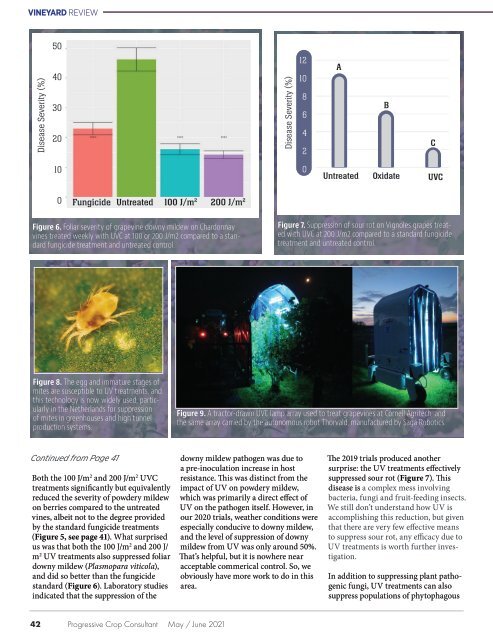Progressive Crop Consultant May/June 2021
You also want an ePaper? Increase the reach of your titles
YUMPU automatically turns print PDFs into web optimized ePapers that Google loves.
VINEYARD REVIEW<br />
Disease Severity (%)<br />
50<br />
40<br />
30<br />
20<br />
Disease Severity (%)<br />
12<br />
10<br />
8<br />
6<br />
4<br />
2<br />
A<br />
B<br />
C<br />
10<br />
0<br />
Untreated<br />
Oxidate<br />
UVC<br />
0<br />
Fungicide Untreated 100 J/m 2 200 J/m 2<br />
Figure 6. Foliar severity of grapevine downy mildew on Chardonnay<br />
vines treated weekly with UVC at 100 or 200 J/m2 compared to a standard<br />
fungicide treatment and untreated control.<br />
Figure 7. Suppression of sour rot on Vignoles grapes treated<br />
with UVC at 200 J/m2 compared to a standard fungicide<br />
treatment and untreated control.<br />
40<br />
12<br />
A<br />
Figure 8. The egg and 10 immature stages of<br />
mites are susceptible to UV treatments, and<br />
this technology is now widely 8 used, particularly<br />
in the Netherlands for suppression<br />
of mites in greenhouses and high tunnel<br />
6<br />
production systems.<br />
Disease Severity (%)<br />
Continued from Page 2 41<br />
Both the 100 J/m 2 and 0 200 J/m 2 UVC<br />
treatments significantly but Untreated equivalently<br />
reduced the severity of powdery mildew<br />
on berries compared to the untreated<br />
vines, albeit not to the degree provided<br />
by the standard fungicide treatments<br />
(Figure 5, see page 41). What surprised<br />
us was that both the 100 J/m 2 and 200 J/<br />
m 2 UV treatments also suppressed foliar<br />
downy mildew (Plasmopara viticola),<br />
and did so better than the fungicide<br />
standard (Figure 6). Laboratory studies<br />
indicated that the suppression of the<br />
4<br />
10<br />
Figure B 9. A tractor-drawn UVC lamp array used to treat grapevines at Cornell Agritech, and<br />
the same array carried by the autonomous robot Thorvald, manufactured by Saga Robotics.<br />
0<br />
Untreated<br />
C<br />
downy mildew pathogen was due to<br />
a pre-inoculation increase in host<br />
resistance. This was distinct from the<br />
Oxidate impact of UV on UVC powdery mildew,<br />
which was primarily a direct effect of<br />
UV on the pathogen itself. However, in<br />
our 2020 trials, weather conditions were<br />
especially conducive to downy mildew,<br />
and the level of suppression of downy<br />
mildew from UV was only around 50%.<br />
That’s helpful, but it is nowhere near<br />
acceptable commerical control. So, we<br />
obviously have more work to do in this<br />
area.<br />
Disease Severity (%)<br />
30<br />
20<br />
The 2019 trials produced another<br />
surprise: the UV treatments effectively<br />
suppressed sour rot (Figure 7). This<br />
disease is a complex mess involving<br />
bacteria, fungi and fruit-feeding insects.<br />
We still don’t understand how UV is<br />
accomplishing this reduction, but given<br />
that there are very few effective means<br />
to suppress sour rot, any efficacy due to<br />
UV treatments is worth further investigation.<br />
In addition to suppressing plant pathogenic<br />
fungi, UV treatments can also<br />
suppress populations of phytophagous<br />
U<br />
42 <strong>Progressive</strong> <strong>Crop</strong> <strong>Consultant</strong> <strong>May</strong> / <strong>June</strong> <strong>2021</strong>


















